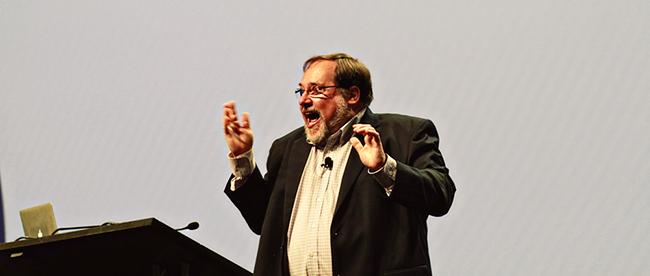TCC12 Keynote Recap: John Medina - Brain Rules
"The human brain seems to have been designed to survive outdoors in unstable meterological conditions. If you wanted to design something which was the ideal environment for getting work done, it wouldn't be a cubicle."
"We don't really know how the brain works. We don't know how we know how to pick up a glass or water or write our names."
Author of Brain Rules: Twelve Principles for Surviving and Thriving at Work, Home, and School and developmental molecular biologist John Medina addressed a full house in the Indigo Ballroom in the second keynote address at the Tableau Customer Conference, and took his time entertaining and educating the listeners on a number of rules about how the brain works, taking the occasional humorous aside to debunk pseudoscience and sheer buncombe myths about how our minds work.

Exercise and the Brain
There is a strong indication that there a strong correlation between exercise and brain functionality.
"Exercise boosts brain power and buffers against stress." Medina notes that, as much as he wished he had counter confirmation, that not only has walking on a treadmill while working helped him shed significant weight, he has noted
that he feels significantly sharper while doing so.
There also seems to be a correlation between exercising and aging very well as well as between not exercising well and aging poorly. Populations who exercise have better outlooks on life, stay active longer, have reduced instances of coronary disease, depression, general dementia; while those who have a sedentary lifestyle show the inverse.
Executive function- the ability to perform mathematical functions and keep emotional controls, for instance, shows a seven-fold higher performance level in a sample of those who exercise over those who don't. Basically, the presence of reasonable aerobic activity levels demonstrably makes you smarter! Tests on a sedentary population who were used to establish a baseline before being asked to change their lifestyle over a sixteen week period showed increases in executive function ranging from an increase of 50 to 150 percent. This improvement was demonstrated with as little exercise as a walking at a brisk pace (Medina defines this as 'walking too fast to sing") for as little as 150 minutes a week.
"What should we take away from this? The workplace of the future might not have cubicles, but walking stations. The corporate dress code may go from being 'whatever' for coders and shirt and tie for everyone else to gym clothes!"

Attentional Considerations
"People don't pay attention to boring things. Plain and simple, if something is boring, there is a marked change in attentional state."
"This is how little we know about how we pay attention and avoid being boring....What do we know about attentional states and what helps us pay attention and keep away from things which are boring? Ever see a spotlight? There's a light and a power supply, and they're connected together by a wire. The whole brain attentional state is connected by a bunch of wiring to the attentional spotlight in the neurological substrate. We know a little about these things and things which affect them, and different portions of the brain control each of them."
Different portions of the brain control the 'light' and the 'power supply'. Communications between the two are handled n a task-by-task basis, and take 0.7 seconds for each query to process. You can't multi-task, because your brain can't parallel process.
"We pay attention to things like emotions, threats and sex. Regardless of who you are, the brain pays a great deal of attention to these questions: Can I eat it? Will it eat me? Have I seen it before? Can I have sex with it? Will it have sex with me?
The brain is not capable of multi-tasking. We can talk and breathe, but when it comes to higher level tasks, we just can't do it."
Oh, and "Did you ever hear that you only use 10% of your brain? Pure mythology. It's at least 60% at rest."
Subscribe to our blog
Ontvang de nieuwste updates van Tableau in je inbox.


